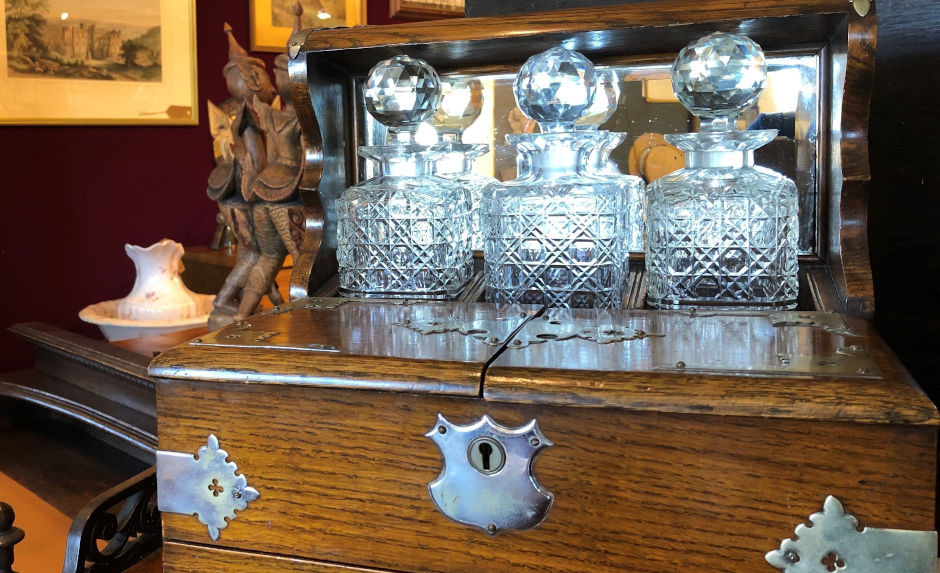
Originally patented in 1881 by George Betjemann, a tantalus is a wooden container for glass decanters, characterised by a lock and key. The basic framework of the piece allows two, three and sometimes four decanters to be secured within it, visible but inaccessible when locked. When secured within the tantalus, the decanters can be neither unstoppered nor removed.
The tantalus was so called after Tantalus, one of the sons of Zeus. The myth says that when invited to dine at the table of the Gods, Tantalus stole some ambrosia for his personal use. As punishment for this crime, Tantalus was forced to stand in a pool of water under a fruit tree. Each time he attempted to drink from the pool, the water receded and each time he tried to reach the fruit, the branches of the tree lifted away from him. This gave rise to the word ‘tantalise’, meaning to torment or tease, something that a tantalus may well have done to those without the key!
George Betjemann, the grandfather of the poet, Sir John, was a Dutch cabinet maker who had workshop premises in London from the 1830s. Betjemann tantaluses were retailed in prestigious outlets including Asprey’s and Mappin & Webb and an original example in complete condition is extremely rare, with those that have survived achieving thousands of pounds at auction.
As the tantalus grew in popularity, the designs and materials used to make them expanded. Today there are many fine examples of the antique tantalus to be found and collectors have a wide variety of styles and materials to choose from. Most commonly, a tantalus decanter set accommodates three bottles, although there are those that hold just one or two and others that contain four. The framework, which usually featured metal carry handles on either side, could be plain or intricately carved.
Typically, the body of a tantalus decanter set has an open, wooden framework, so that the decanters can be seen and admired from all angles, but there are pieces which are a closed box. These closed box tantaluses will often feature a mirrored back allowing the decanters to be viewed more fully. Collectors can choose from pieces made in a variety of woods, including mahogany, burr walnut, English oak, cherry, and satinwood.
More detailed and intricate tantalus sets often feature drawers and/or compartments in which gentlemen’s gaming paraphernalia such as cribbage boards and decks of cards could be stored. These drawers are often to be found inlaid with shell or contrasting wood designs, and while the majority of antique tantaluses were designed to be table top pieces, there are some that were full-sized pieces of furniture.
The mounts and handles on an antique tantalus decanter set can be as diverse as the wood, with brass, sterling silver, and silver plate being the most popular.
When looking for a quality tantalus, however, the collector should pay special attention to the decanters, which should be original and match. More sought-after examples will feature deeply hand cut glass bottles with the original stoppers, that can be associated with reputable manufacturers such as Waterford.
It is a true delight to the collector of the antique tantalus to come across an example with the original key and a lock in working order – the size and nature of the keys mean that these were often lost or misplaced over time. A tantalus may have its’ lock in the bar situated over the top of the decanters or in the rail at the front. A coveted manufacturer in tantalus locks is Bramah, the oldest security company in London, dating back to 1784. Joseph Bramah patented his lock design in 1787 and his name became synonymous with engineering excellence. Pre-dating Chubb and Yale locks, original Bramah locks can be found on the highest quality pieces of furniture.
The Holy Grail for collectors of antique tantaluses would be an original Betjemann piece. Featuring a Bramah lock stamped with the Betjemann patent, with the patent number and maker’s crest, as well as the original key, the tantalus would also bear an inscription reading ‘The Tantalus’.
A visit to the Hemswell Antique Centres will allow you to view our antiques at your leisure in comfortable surroundings, with the option to take a welcome break in one of our restaurants. Welcoming visitors from all over the world, we offer dealers the ideal environment for connecting with new buyers, while for those who cannot visit in person, our website showcases the finest pieces we have to offer.